Management Theory and Practice
VerifiedAdded on 2023/06/04
|12
|3428
|420
AI Summary
This essay provides a critical analysis of the three major theories of organization - institutional theory, population ecology theory, and resource dependency theory. It also explains the fundamental dimensions of organizational design and how they can assist in developing organizational structure. The essay concludes that resource dependency theory is the most compelling theory for determinism.
Contribute Materials
Your contribution can guide someone’s learning journey. Share your
documents today.
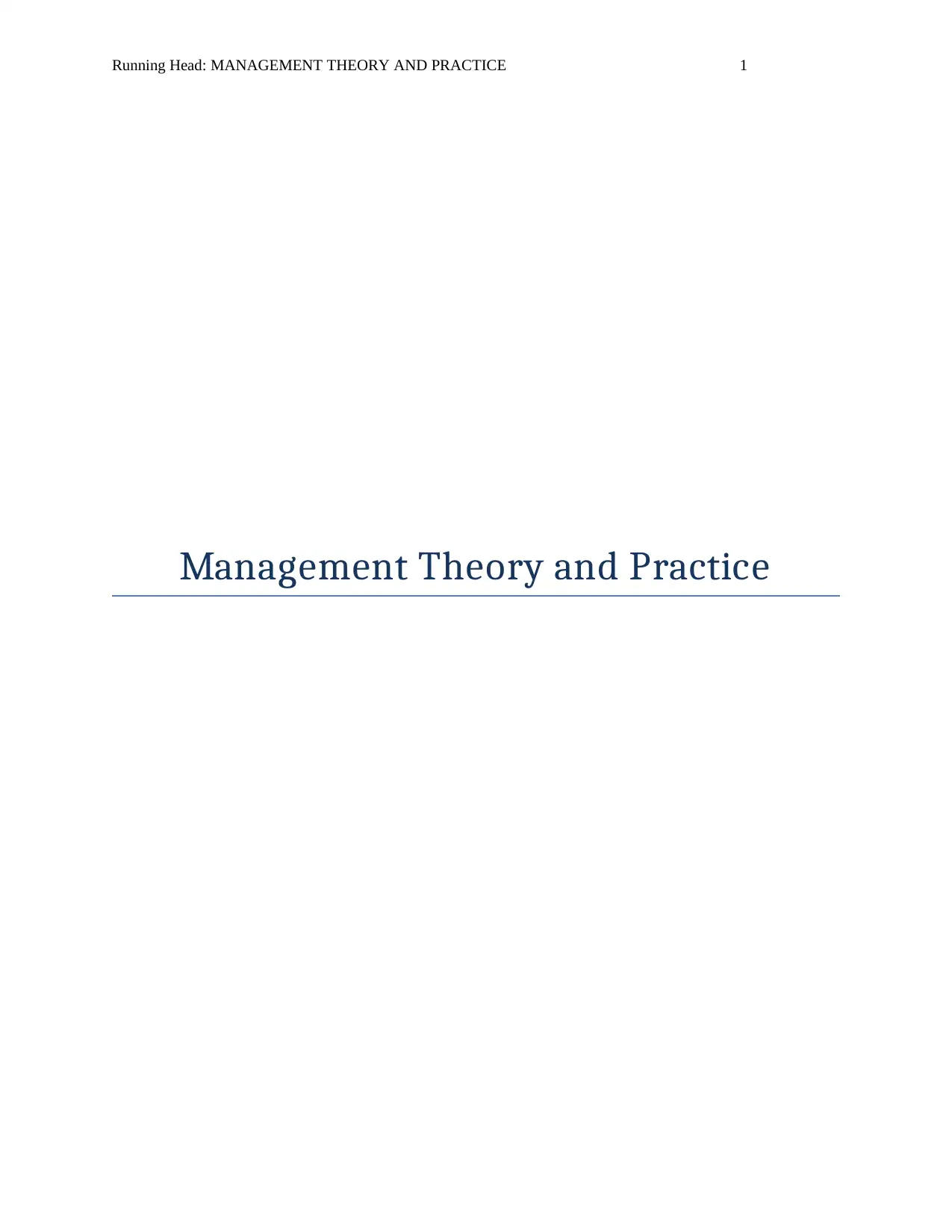
Running Head: MANAGEMENT THEORY AND PRACTICE 1
Management Theory and Practice
Management Theory and Practice
Secure Best Marks with AI Grader
Need help grading? Try our AI Grader for instant feedback on your assignments.

MANAGEMENT THEORY AND PRACTICE 2
Introduction
Organizational theories are the approaches which can be used for analyzing the organization.
Organizations can be defined as the people’s social units which are developed and managed to
fulfill a requirement or to practice the mutual objectives. Some of the scholars claim that
arguments among different organizational theories indicate the competition level of these
theories. Some authors suppose that these theories are resulted from research findings and
implemented to resolve real-world issuesi.
The objective of this essay is to answer the question that “can different organizational theories
can be reconciled into a single theory of organization”. In this essay, it is done by critically
analyzing different theories and identifying the opinions of different authors. There are three
different theories of organization i.e. institutional theory, population ecology theory and resource
dependency theory. All of these are popular as deterministic theories which contribute to the
organizational actions and design. Firstly, the paper provides a brief introduction about three
major dimensions of organizational design. Secondly, a paradigmatic controversy is initiated and
all three theories are analyzed critically. At the end, the above stated question is answered and
conclusion is given.
Fundamental Dimensions
In modern business environment, organization is like an open system as it affects and gets
affected by their internal and external environment. It works as a social unit of persons which is
organized and structured to reach its collective goals. An organization has a management
structure which determines the relationship between different members and actionsii. This
structure divides and allocates the responsibilities, roles and authority to practice different tasks.
In this context, open system concept states that organization is defined as a system that converts
inputs from external atmosphere through transformation mechanism with the production
technology and management to specific results. This transformation is provided by the
components inside the company that includes many related stakeholders like employees and
managers. According to Gurianova and Mechtcheriakova (2015) described organizational
structure as a framework and model of interactions and relations between different parts and
sections of an entity. In today’s organizations, there are different types of structure that are
Introduction
Organizational theories are the approaches which can be used for analyzing the organization.
Organizations can be defined as the people’s social units which are developed and managed to
fulfill a requirement or to practice the mutual objectives. Some of the scholars claim that
arguments among different organizational theories indicate the competition level of these
theories. Some authors suppose that these theories are resulted from research findings and
implemented to resolve real-world issuesi.
The objective of this essay is to answer the question that “can different organizational theories
can be reconciled into a single theory of organization”. In this essay, it is done by critically
analyzing different theories and identifying the opinions of different authors. There are three
different theories of organization i.e. institutional theory, population ecology theory and resource
dependency theory. All of these are popular as deterministic theories which contribute to the
organizational actions and design. Firstly, the paper provides a brief introduction about three
major dimensions of organizational design. Secondly, a paradigmatic controversy is initiated and
all three theories are analyzed critically. At the end, the above stated question is answered and
conclusion is given.
Fundamental Dimensions
In modern business environment, organization is like an open system as it affects and gets
affected by their internal and external environment. It works as a social unit of persons which is
organized and structured to reach its collective goals. An organization has a management
structure which determines the relationship between different members and actionsii. This
structure divides and allocates the responsibilities, roles and authority to practice different tasks.
In this context, open system concept states that organization is defined as a system that converts
inputs from external atmosphere through transformation mechanism with the production
technology and management to specific results. This transformation is provided by the
components inside the company that includes many related stakeholders like employees and
managers. According to Gurianova and Mechtcheriakova (2015) described organizational
structure as a framework and model of interactions and relations between different parts and
sections of an entity. In today’s organizations, there are different types of structure that are
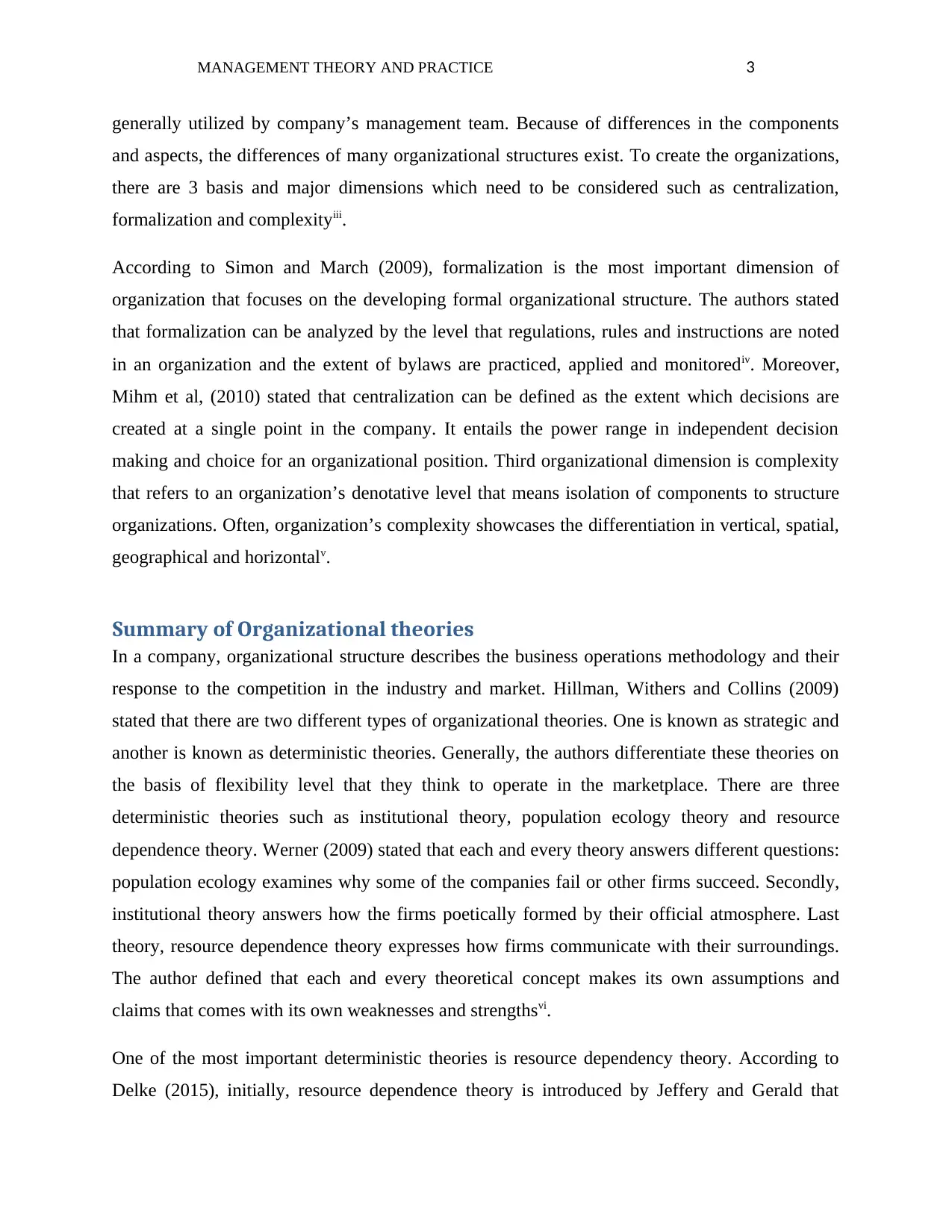
MANAGEMENT THEORY AND PRACTICE 3
generally utilized by company’s management team. Because of differences in the components
and aspects, the differences of many organizational structures exist. To create the organizations,
there are 3 basis and major dimensions which need to be considered such as centralization,
formalization and complexityiii.
According to Simon and March (2009), formalization is the most important dimension of
organization that focuses on the developing formal organizational structure. The authors stated
that formalization can be analyzed by the level that regulations, rules and instructions are noted
in an organization and the extent of bylaws are practiced, applied and monitorediv. Moreover,
Mihm et al, (2010) stated that centralization can be defined as the extent which decisions are
created at a single point in the company. It entails the power range in independent decision
making and choice for an organizational position. Third organizational dimension is complexity
that refers to an organization’s denotative level that means isolation of components to structure
organizations. Often, organization’s complexity showcases the differentiation in vertical, spatial,
geographical and horizontalv.
Summary of Organizational theories
In a company, organizational structure describes the business operations methodology and their
response to the competition in the industry and market. Hillman, Withers and Collins (2009)
stated that there are two different types of organizational theories. One is known as strategic and
another is known as deterministic theories. Generally, the authors differentiate these theories on
the basis of flexibility level that they think to operate in the marketplace. There are three
deterministic theories such as institutional theory, population ecology theory and resource
dependence theory. Werner (2009) stated that each and every theory answers different questions:
population ecology examines why some of the companies fail or other firms succeed. Secondly,
institutional theory answers how the firms poetically formed by their official atmosphere. Last
theory, resource dependence theory expresses how firms communicate with their surroundings.
The author defined that each and every theoretical concept makes its own assumptions and
claims that comes with its own weaknesses and strengthsvi.
One of the most important deterministic theories is resource dependency theory. According to
Delke (2015), initially, resource dependence theory is introduced by Jeffery and Gerald that
generally utilized by company’s management team. Because of differences in the components
and aspects, the differences of many organizational structures exist. To create the organizations,
there are 3 basis and major dimensions which need to be considered such as centralization,
formalization and complexityiii.
According to Simon and March (2009), formalization is the most important dimension of
organization that focuses on the developing formal organizational structure. The authors stated
that formalization can be analyzed by the level that regulations, rules and instructions are noted
in an organization and the extent of bylaws are practiced, applied and monitorediv. Moreover,
Mihm et al, (2010) stated that centralization can be defined as the extent which decisions are
created at a single point in the company. It entails the power range in independent decision
making and choice for an organizational position. Third organizational dimension is complexity
that refers to an organization’s denotative level that means isolation of components to structure
organizations. Often, organization’s complexity showcases the differentiation in vertical, spatial,
geographical and horizontalv.
Summary of Organizational theories
In a company, organizational structure describes the business operations methodology and their
response to the competition in the industry and market. Hillman, Withers and Collins (2009)
stated that there are two different types of organizational theories. One is known as strategic and
another is known as deterministic theories. Generally, the authors differentiate these theories on
the basis of flexibility level that they think to operate in the marketplace. There are three
deterministic theories such as institutional theory, population ecology theory and resource
dependence theory. Werner (2009) stated that each and every theory answers different questions:
population ecology examines why some of the companies fail or other firms succeed. Secondly,
institutional theory answers how the firms poetically formed by their official atmosphere. Last
theory, resource dependence theory expresses how firms communicate with their surroundings.
The author defined that each and every theoretical concept makes its own assumptions and
claims that comes with its own weaknesses and strengthsvi.
One of the most important deterministic theories is resource dependency theory. According to
Delke (2015), initially, resource dependence theory is introduced by Jeffery and Gerald that

MANAGEMENT THEORY AND PRACTICE 4
majorly emphasizes on the description of power-seeking behavior of firms. This theoretical
concept considers the link between the organization and dependent resource holder. As per this
theory, the agents are entreated to figure out priorities for dependent resources which are needed
by the firms and which suppliers are. The management team should have an obvious
understanding about the supply chain, rare resources and balance needed resources by the firms.
Later, they can implement different techniques and strategies on the needs of resources to
eliminate the dependenciesvii.
In this context, Cobb and Davis (2010) have expressed their opinions that an organization
possesses different kinds of resources like financial resources, raw materials, intangible, tangible
resources, human resources, finished goods and other required resources. When a firm manages
its resources, other firm will be totally dependent on the first one. This dependency among
different entities can cause uncertainty in external environment of business. Thus, there is a need
of operational planning and they need to make additional efforts to overcome different
challenges and risksviii.
One of the best examples to understand this theory is ACME Company that is working as an IT
form. Currently, it is offering its services to a media company, named as XYZ multimedia firm.
This example showcases that IT firm totally depends on XYZ Company as it is the only way that
supports it to generate great revenues. In this situation, the companies may face different risks
and challenges while implementing the concept of resource dependence. In order to overcome
these challenges and risks, ACME Company needs to look for other entities so that it can decline
the dependency level on XYZ multimediaix. For using different resources and organizational
assets, the agents and managers need to apply and utilize different techniques like mergers, joint
ventures, acquisitions and other methods. In this way, it can be recognized that resource
dependence theory provides the basis for knowing about the behavioral impacts of company.
Along with above theory, institutional theory is another theory that plays a vital role in
development of organization’s actions and design. According to Thoenig (2011), institutional
theory is an organizational theory that emphasizes on the set of values and norms that develops
organizational behavior. Generally, the scholars think that companies tend to be same because of
shaping by their official environment. This theory states that institutional environment of a firm
includes the regulations, rules and norms to which companies must abide for maintaining support
majorly emphasizes on the description of power-seeking behavior of firms. This theoretical
concept considers the link between the organization and dependent resource holder. As per this
theory, the agents are entreated to figure out priorities for dependent resources which are needed
by the firms and which suppliers are. The management team should have an obvious
understanding about the supply chain, rare resources and balance needed resources by the firms.
Later, they can implement different techniques and strategies on the needs of resources to
eliminate the dependenciesvii.
In this context, Cobb and Davis (2010) have expressed their opinions that an organization
possesses different kinds of resources like financial resources, raw materials, intangible, tangible
resources, human resources, finished goods and other required resources. When a firm manages
its resources, other firm will be totally dependent on the first one. This dependency among
different entities can cause uncertainty in external environment of business. Thus, there is a need
of operational planning and they need to make additional efforts to overcome different
challenges and risksviii.
One of the best examples to understand this theory is ACME Company that is working as an IT
form. Currently, it is offering its services to a media company, named as XYZ multimedia firm.
This example showcases that IT firm totally depends on XYZ Company as it is the only way that
supports it to generate great revenues. In this situation, the companies may face different risks
and challenges while implementing the concept of resource dependence. In order to overcome
these challenges and risks, ACME Company needs to look for other entities so that it can decline
the dependency level on XYZ multimediaix. For using different resources and organizational
assets, the agents and managers need to apply and utilize different techniques like mergers, joint
ventures, acquisitions and other methods. In this way, it can be recognized that resource
dependence theory provides the basis for knowing about the behavioral impacts of company.
Along with above theory, institutional theory is another theory that plays a vital role in
development of organization’s actions and design. According to Thoenig (2011), institutional
theory is an organizational theory that emphasizes on the set of values and norms that develops
organizational behavior. Generally, the scholars think that companies tend to be same because of
shaping by their official environment. This theory states that institutional environment of a firm
includes the regulations, rules and norms to which companies must abide for maintaining support
Secure Best Marks with AI Grader
Need help grading? Try our AI Grader for instant feedback on your assignments.
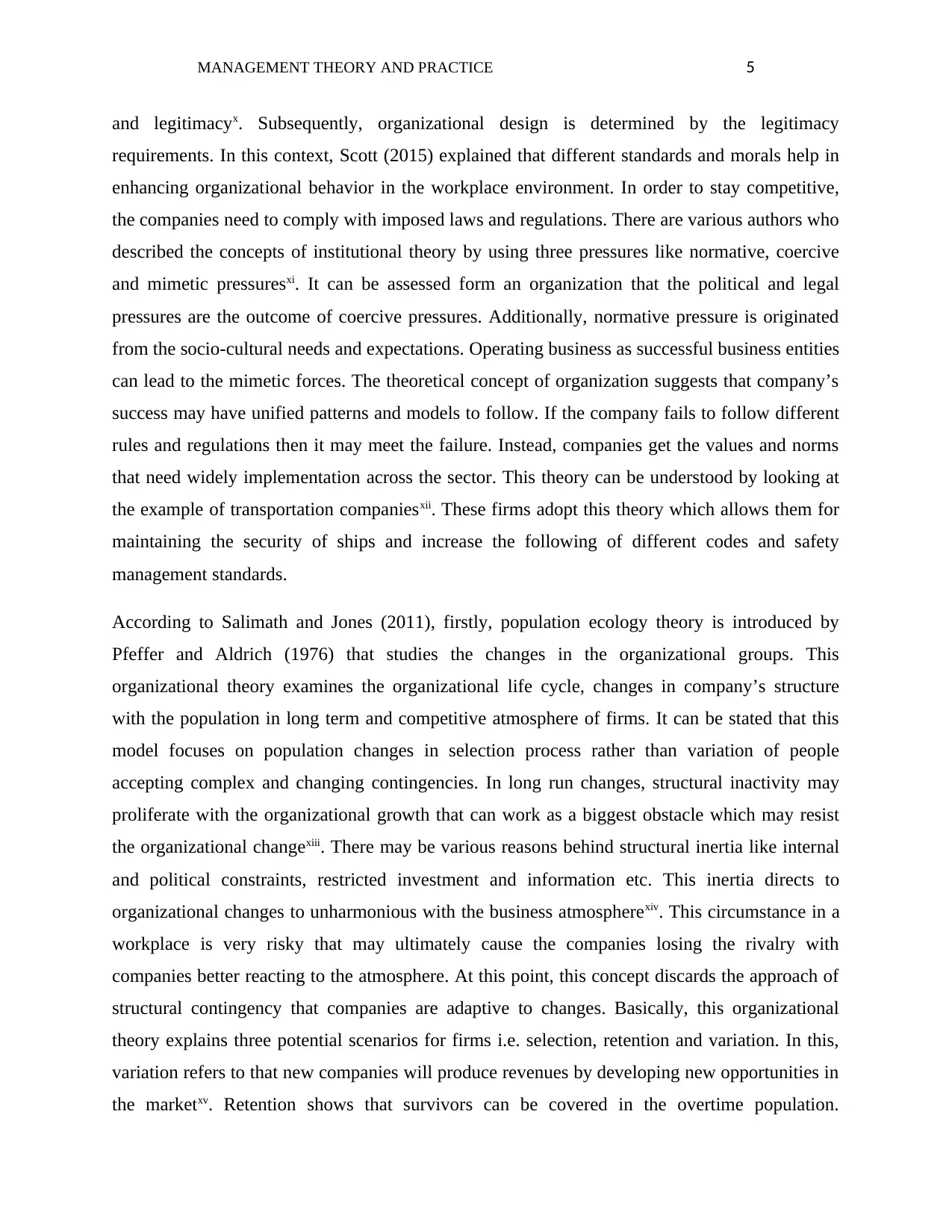
MANAGEMENT THEORY AND PRACTICE 5
and legitimacyx. Subsequently, organizational design is determined by the legitimacy
requirements. In this context, Scott (2015) explained that different standards and morals help in
enhancing organizational behavior in the workplace environment. In order to stay competitive,
the companies need to comply with imposed laws and regulations. There are various authors who
described the concepts of institutional theory by using three pressures like normative, coercive
and mimetic pressuresxi. It can be assessed form an organization that the political and legal
pressures are the outcome of coercive pressures. Additionally, normative pressure is originated
from the socio-cultural needs and expectations. Operating business as successful business entities
can lead to the mimetic forces. The theoretical concept of organization suggests that company’s
success may have unified patterns and models to follow. If the company fails to follow different
rules and regulations then it may meet the failure. Instead, companies get the values and norms
that need widely implementation across the sector. This theory can be understood by looking at
the example of transportation companiesxii. These firms adopt this theory which allows them for
maintaining the security of ships and increase the following of different codes and safety
management standards.
According to Salimath and Jones (2011), firstly, population ecology theory is introduced by
Pfeffer and Aldrich (1976) that studies the changes in the organizational groups. This
organizational theory examines the organizational life cycle, changes in company’s structure
with the population in long term and competitive atmosphere of firms. It can be stated that this
model focuses on population changes in selection process rather than variation of people
accepting complex and changing contingencies. In long run changes, structural inactivity may
proliferate with the organizational growth that can work as a biggest obstacle which may resist
the organizational changexiii. There may be various reasons behind structural inertia like internal
and political constraints, restricted investment and information etc. This inertia directs to
organizational changes to unharmonious with the business atmospherexiv. This circumstance in a
workplace is very risky that may ultimately cause the companies losing the rivalry with
companies better reacting to the atmosphere. At this point, this concept discards the approach of
structural contingency that companies are adaptive to changes. Basically, this organizational
theory explains three potential scenarios for firms i.e. selection, retention and variation. In this,
variation refers to that new companies will produce revenues by developing new opportunities in
the marketxv. Retention shows that survivors can be covered in the overtime population.
and legitimacyx. Subsequently, organizational design is determined by the legitimacy
requirements. In this context, Scott (2015) explained that different standards and morals help in
enhancing organizational behavior in the workplace environment. In order to stay competitive,
the companies need to comply with imposed laws and regulations. There are various authors who
described the concepts of institutional theory by using three pressures like normative, coercive
and mimetic pressuresxi. It can be assessed form an organization that the political and legal
pressures are the outcome of coercive pressures. Additionally, normative pressure is originated
from the socio-cultural needs and expectations. Operating business as successful business entities
can lead to the mimetic forces. The theoretical concept of organization suggests that company’s
success may have unified patterns and models to follow. If the company fails to follow different
rules and regulations then it may meet the failure. Instead, companies get the values and norms
that need widely implementation across the sector. This theory can be understood by looking at
the example of transportation companiesxii. These firms adopt this theory which allows them for
maintaining the security of ships and increase the following of different codes and safety
management standards.
According to Salimath and Jones (2011), firstly, population ecology theory is introduced by
Pfeffer and Aldrich (1976) that studies the changes in the organizational groups. This
organizational theory examines the organizational life cycle, changes in company’s structure
with the population in long term and competitive atmosphere of firms. It can be stated that this
model focuses on population changes in selection process rather than variation of people
accepting complex and changing contingencies. In long run changes, structural inactivity may
proliferate with the organizational growth that can work as a biggest obstacle which may resist
the organizational changexiii. There may be various reasons behind structural inertia like internal
and political constraints, restricted investment and information etc. This inertia directs to
organizational changes to unharmonious with the business atmospherexiv. This circumstance in a
workplace is very risky that may ultimately cause the companies losing the rivalry with
companies better reacting to the atmosphere. At this point, this concept discards the approach of
structural contingency that companies are adaptive to changes. Basically, this organizational
theory explains three potential scenarios for firms i.e. selection, retention and variation. In this,
variation refers to that new companies will produce revenues by developing new opportunities in
the marketxv. Retention shows that survivors can be covered in the overtime population.
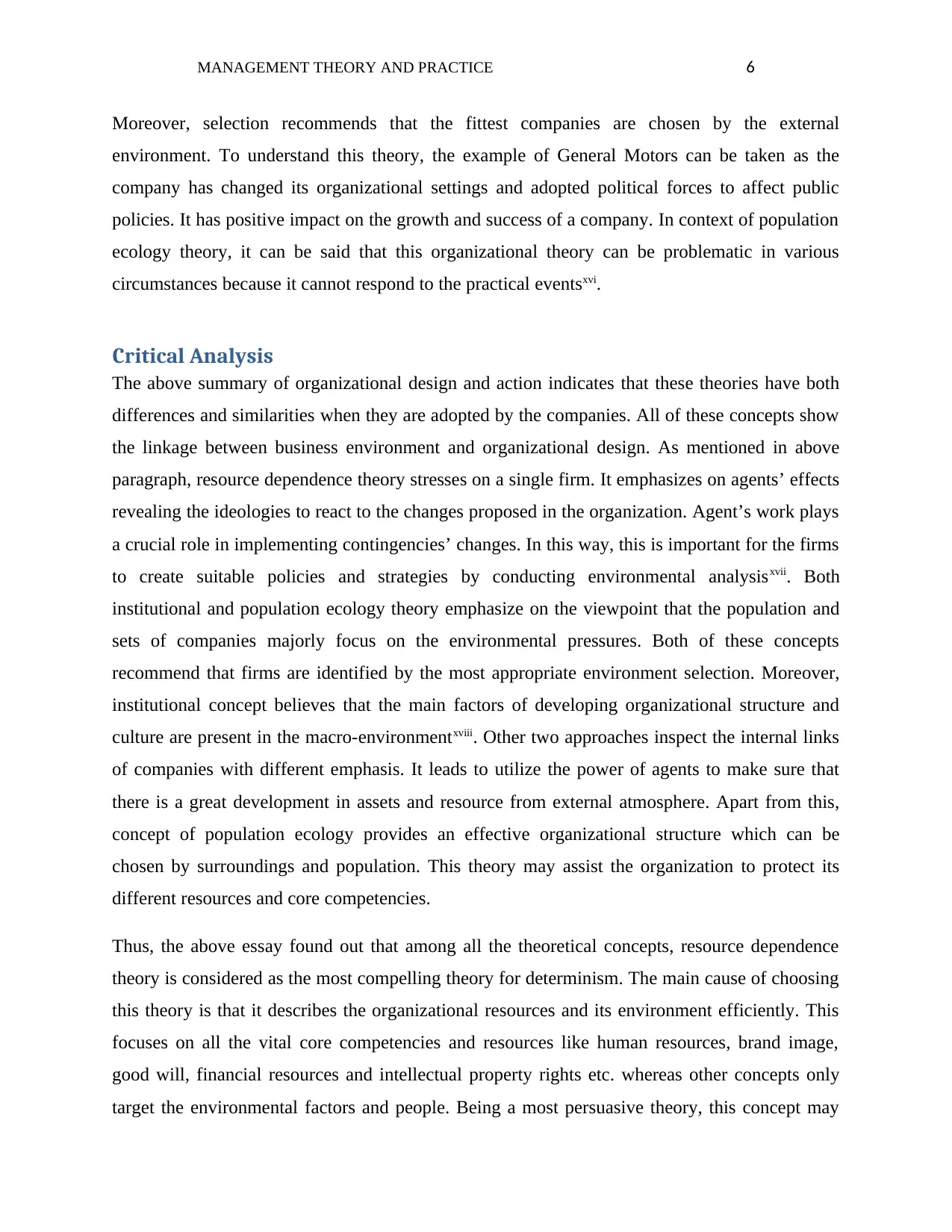
MANAGEMENT THEORY AND PRACTICE 6
Moreover, selection recommends that the fittest companies are chosen by the external
environment. To understand this theory, the example of General Motors can be taken as the
company has changed its organizational settings and adopted political forces to affect public
policies. It has positive impact on the growth and success of a company. In context of population
ecology theory, it can be said that this organizational theory can be problematic in various
circumstances because it cannot respond to the practical eventsxvi.
Critical Analysis
The above summary of organizational design and action indicates that these theories have both
differences and similarities when they are adopted by the companies. All of these concepts show
the linkage between business environment and organizational design. As mentioned in above
paragraph, resource dependence theory stresses on a single firm. It emphasizes on agents’ effects
revealing the ideologies to react to the changes proposed in the organization. Agent’s work plays
a crucial role in implementing contingencies’ changes. In this way, this is important for the firms
to create suitable policies and strategies by conducting environmental analysisxvii. Both
institutional and population ecology theory emphasize on the viewpoint that the population and
sets of companies majorly focus on the environmental pressures. Both of these concepts
recommend that firms are identified by the most appropriate environment selection. Moreover,
institutional concept believes that the main factors of developing organizational structure and
culture are present in the macro-environmentxviii. Other two approaches inspect the internal links
of companies with different emphasis. It leads to utilize the power of agents to make sure that
there is a great development in assets and resource from external atmosphere. Apart from this,
concept of population ecology provides an effective organizational structure which can be
chosen by surroundings and population. This theory may assist the organization to protect its
different resources and core competencies.
Thus, the above essay found out that among all the theoretical concepts, resource dependence
theory is considered as the most compelling theory for determinism. The main cause of choosing
this theory is that it describes the organizational resources and its environment efficiently. This
focuses on all the vital core competencies and resources like human resources, brand image,
good will, financial resources and intellectual property rights etc. whereas other concepts only
target the environmental factors and people. Being a most persuasive theory, this concept may
Moreover, selection recommends that the fittest companies are chosen by the external
environment. To understand this theory, the example of General Motors can be taken as the
company has changed its organizational settings and adopted political forces to affect public
policies. It has positive impact on the growth and success of a company. In context of population
ecology theory, it can be said that this organizational theory can be problematic in various
circumstances because it cannot respond to the practical eventsxvi.
Critical Analysis
The above summary of organizational design and action indicates that these theories have both
differences and similarities when they are adopted by the companies. All of these concepts show
the linkage between business environment and organizational design. As mentioned in above
paragraph, resource dependence theory stresses on a single firm. It emphasizes on agents’ effects
revealing the ideologies to react to the changes proposed in the organization. Agent’s work plays
a crucial role in implementing contingencies’ changes. In this way, this is important for the firms
to create suitable policies and strategies by conducting environmental analysisxvii. Both
institutional and population ecology theory emphasize on the viewpoint that the population and
sets of companies majorly focus on the environmental pressures. Both of these concepts
recommend that firms are identified by the most appropriate environment selection. Moreover,
institutional concept believes that the main factors of developing organizational structure and
culture are present in the macro-environmentxviii. Other two approaches inspect the internal links
of companies with different emphasis. It leads to utilize the power of agents to make sure that
there is a great development in assets and resource from external atmosphere. Apart from this,
concept of population ecology provides an effective organizational structure which can be
chosen by surroundings and population. This theory may assist the organization to protect its
different resources and core competencies.
Thus, the above essay found out that among all the theoretical concepts, resource dependence
theory is considered as the most compelling theory for determinism. The main cause of choosing
this theory is that it describes the organizational resources and its environment efficiently. This
focuses on all the vital core competencies and resources like human resources, brand image,
good will, financial resources and intellectual property rights etc. whereas other concepts only
target the environmental factors and people. Being a most persuasive theory, this concept may
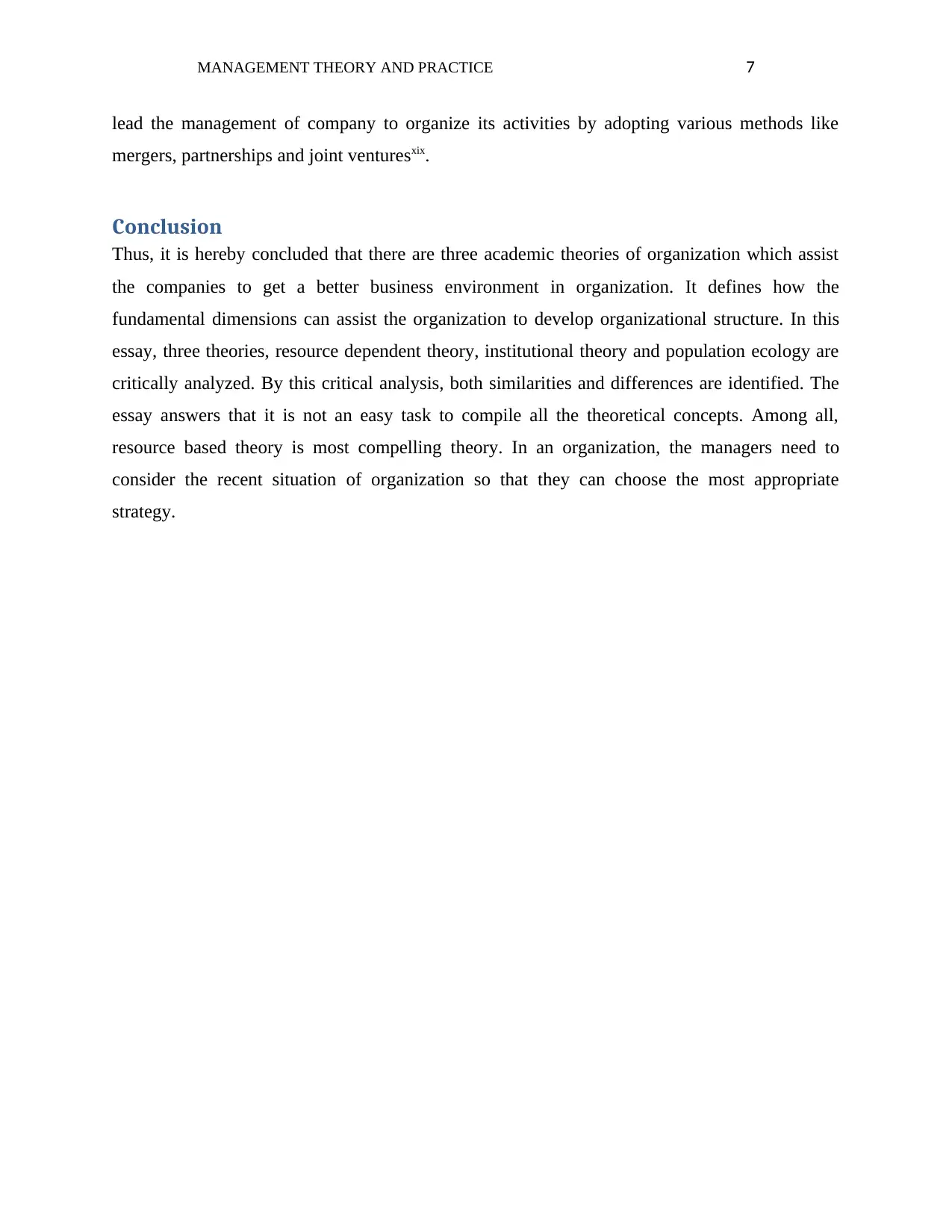
MANAGEMENT THEORY AND PRACTICE 7
lead the management of company to organize its activities by adopting various methods like
mergers, partnerships and joint venturesxix.
Conclusion
Thus, it is hereby concluded that there are three academic theories of organization which assist
the companies to get a better business environment in organization. It defines how the
fundamental dimensions can assist the organization to develop organizational structure. In this
essay, three theories, resource dependent theory, institutional theory and population ecology are
critically analyzed. By this critical analysis, both similarities and differences are identified. The
essay answers that it is not an easy task to compile all the theoretical concepts. Among all,
resource based theory is most compelling theory. In an organization, the managers need to
consider the recent situation of organization so that they can choose the most appropriate
strategy.
lead the management of company to organize its activities by adopting various methods like
mergers, partnerships and joint venturesxix.
Conclusion
Thus, it is hereby concluded that there are three academic theories of organization which assist
the companies to get a better business environment in organization. It defines how the
fundamental dimensions can assist the organization to develop organizational structure. In this
essay, three theories, resource dependent theory, institutional theory and population ecology are
critically analyzed. By this critical analysis, both similarities and differences are identified. The
essay answers that it is not an easy task to compile all the theoretical concepts. Among all,
resource based theory is most compelling theory. In an organization, the managers need to
consider the recent situation of organization so that they can choose the most appropriate
strategy.
Paraphrase This Document
Need a fresh take? Get an instant paraphrase of this document with our AI Paraphraser
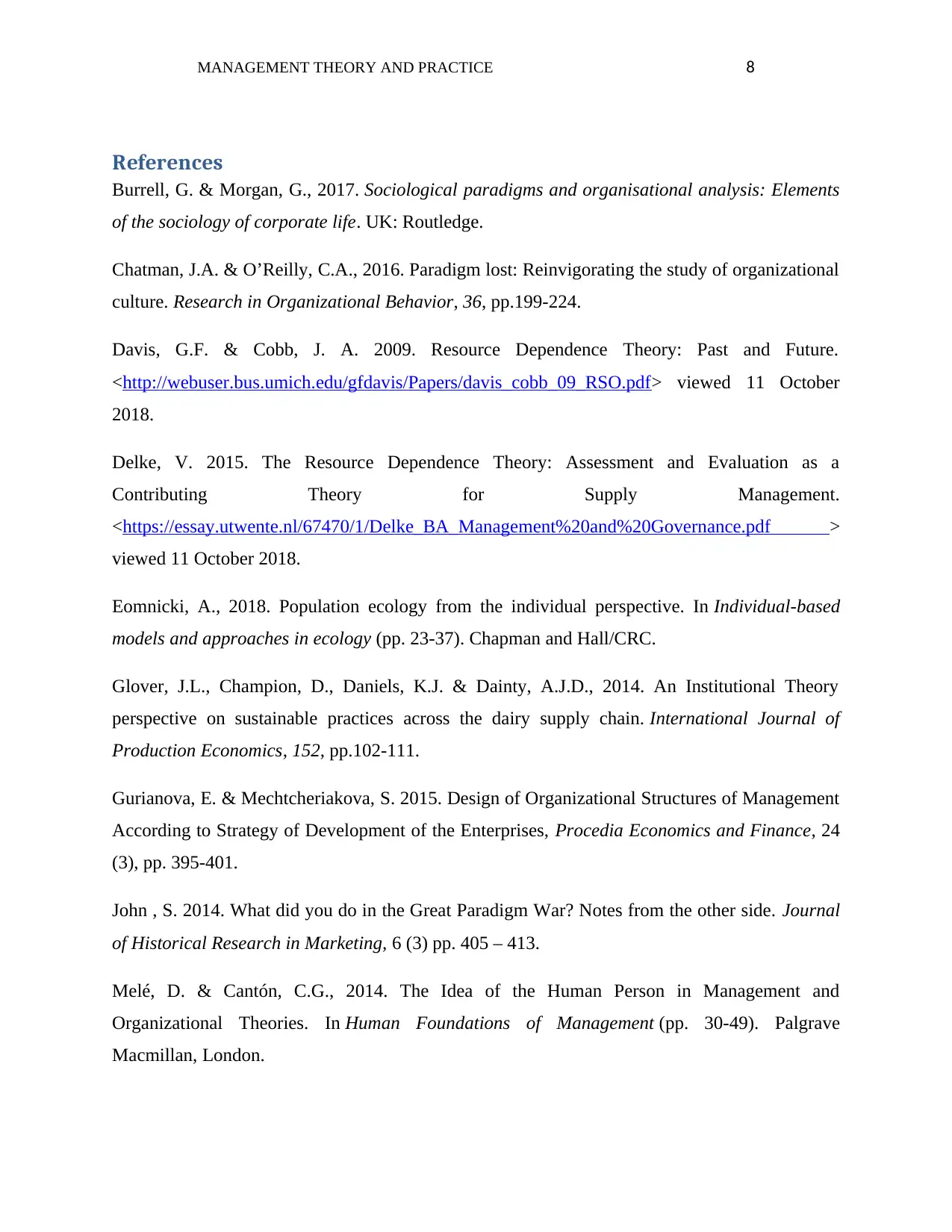
MANAGEMENT THEORY AND PRACTICE 8
References
Burrell, G. & Morgan, G., 2017. Sociological paradigms and organisational analysis: Elements
of the sociology of corporate life. UK: Routledge.
Chatman, J.A. & O’Reilly, C.A., 2016. Paradigm lost: Reinvigorating the study of organizational
culture. Research in Organizational Behavior, 36, pp.199-224.
Davis, G.F. & Cobb, J. A. 2009. Resource Dependence Theory: Past and Future.
<http://webuser.bus.umich.edu/gfdavis/Papers/davis_cobb_09_RSO.pdf> viewed 11 October
2018.
Delke, V. 2015. The Resource Dependence Theory: Assessment and Evaluation as a
Contributing Theory for Supply Management.
<https://essay.utwente.nl/67470/1/Delke_BA_Management%20and%20Governance.pdf >
viewed 11 October 2018.
Eomnicki, A., 2018. Population ecology from the individual perspective. In Individual-based
models and approaches in ecology (pp. 23-37). Chapman and Hall/CRC.
Glover, J.L., Champion, D., Daniels, K.J. & Dainty, A.J.D., 2014. An Institutional Theory
perspective on sustainable practices across the dairy supply chain. International Journal of
Production Economics, 152, pp.102-111.
Gurianova, E. & Mechtcheriakova, S. 2015. Design of Organizational Structures of Management
According to Strategy of Development of the Enterprises, Procedia Economics and Finance, 24
(3), pp. 395-401.
John , S. 2014. What did you do in the Great Paradigm War? Notes from the other side. Journal
of Historical Research in Marketing, 6 (3) pp. 405 – 413.
Melé, D. & Cantón, C.G., 2014. The Idea of the Human Person in Management and
Organizational Theories. In Human Foundations of Management (pp. 30-49). Palgrave
Macmillan, London.
References
Burrell, G. & Morgan, G., 2017. Sociological paradigms and organisational analysis: Elements
of the sociology of corporate life. UK: Routledge.
Chatman, J.A. & O’Reilly, C.A., 2016. Paradigm lost: Reinvigorating the study of organizational
culture. Research in Organizational Behavior, 36, pp.199-224.
Davis, G.F. & Cobb, J. A. 2009. Resource Dependence Theory: Past and Future.
<http://webuser.bus.umich.edu/gfdavis/Papers/davis_cobb_09_RSO.pdf> viewed 11 October
2018.
Delke, V. 2015. The Resource Dependence Theory: Assessment and Evaluation as a
Contributing Theory for Supply Management.
<https://essay.utwente.nl/67470/1/Delke_BA_Management%20and%20Governance.pdf >
viewed 11 October 2018.
Eomnicki, A., 2018. Population ecology from the individual perspective. In Individual-based
models and approaches in ecology (pp. 23-37). Chapman and Hall/CRC.
Glover, J.L., Champion, D., Daniels, K.J. & Dainty, A.J.D., 2014. An Institutional Theory
perspective on sustainable practices across the dairy supply chain. International Journal of
Production Economics, 152, pp.102-111.
Gurianova, E. & Mechtcheriakova, S. 2015. Design of Organizational Structures of Management
According to Strategy of Development of the Enterprises, Procedia Economics and Finance, 24
(3), pp. 395-401.
John , S. 2014. What did you do in the Great Paradigm War? Notes from the other side. Journal
of Historical Research in Marketing, 6 (3) pp. 405 – 413.
Melé, D. & Cantón, C.G., 2014. The Idea of the Human Person in Management and
Organizational Theories. In Human Foundations of Management (pp. 30-49). Palgrave
Macmillan, London.

MANAGEMENT THEORY AND PRACTICE 9
Mihm, J. L., Christoph, H., Wilkinson, D., & Huberman, B. A. 2010. Hierarchical structure and
search in complex organizations. Management Science, 56 (5) pp. 831- 848.
Nilsen, P., 2015. Making sense of implementation theories, models and
frameworks. Implementation Science, 10(1), p.53.
Salimath, M.S. & Jones, R. 2011. Population ecology theory: implications for sustainability.
Management Decision, 49 (6) pp.874-910.
Scott, W.R., 2015. Organizations and organizing: Rational, natural and open systems
perspectives. UK: Routledge.
Simon, H. & March, J., 2009. Organizations. Blackwell, Cambridge.
Suddaby, R., 2015. Can institutional theory be critical?. Journal of Management Inquiry, 24(1),
pp.93-95.
Thoenig, J. C. 2011. Institutional Theories and Public Institutions. < https://halshs.archives-
ouvertes.fr/halshs-00638348/document > viewed 11 October 2018.
Werner, N. 2008. Resource dependence theory: How well does it explain behavior of
organizations?, Management Revue, 19 (1), pp. 9-32.
Mihm, J. L., Christoph, H., Wilkinson, D., & Huberman, B. A. 2010. Hierarchical structure and
search in complex organizations. Management Science, 56 (5) pp. 831- 848.
Nilsen, P., 2015. Making sense of implementation theories, models and
frameworks. Implementation Science, 10(1), p.53.
Salimath, M.S. & Jones, R. 2011. Population ecology theory: implications for sustainability.
Management Decision, 49 (6) pp.874-910.
Scott, W.R., 2015. Organizations and organizing: Rational, natural and open systems
perspectives. UK: Routledge.
Simon, H. & March, J., 2009. Organizations. Blackwell, Cambridge.
Suddaby, R., 2015. Can institutional theory be critical?. Journal of Management Inquiry, 24(1),
pp.93-95.
Thoenig, J. C. 2011. Institutional Theories and Public Institutions. < https://halshs.archives-
ouvertes.fr/halshs-00638348/document > viewed 11 October 2018.
Werner, N. 2008. Resource dependence theory: How well does it explain behavior of
organizations?, Management Revue, 19 (1), pp. 9-32.

MANAGEMENT THEORY AND PRACTICE 10
Secure Best Marks with AI Grader
Need help grading? Try our AI Grader for instant feedback on your assignments.

i Melé, D. & Cantón, C.G., 2014. The Idea of the Human Person in Management and Organizational Theories.
In Human Foundations of Management (pp. 30-49). Palgrave Macmillan, London.
ii Burrell, G. & Morgan, G., 2017. Sociological paradigms and organisational analysis: Elements of the
sociology of corporate life. UK: Routledge.
iii Gurianova, E. & Mechtcheriakova, S. 2015. Design of Organizational Structures of Management According to
Strategy of Development of the Enterprises, Procedia Economics and Finance, 24 (3), pp. 395-401.
iv Simon, H. & March, J., 2009. Organizations. Blackwell, Cambridge.
v Mihm, J. L., Christoph, H., Wilkinson, D., & Huberman, B. A. 2010. Hierarchical structure and search in
complex organizations. Management Science, 56 (5) pp. 831- 848.
vi Werner, N. 2008. Resource dependence theory: How well does it explain behavior of organizations?,
Management Revue, 19 (1), pp. 9-32.
vii Delke, V. 2015. The Resource Dependence Theory: Assessment and Evaluation as a Contributing Theory for
Supply Management. <https://essay.utwente.nl/67470/1/Delke_BA_Management%20and%20Governance.pdf >
viewed 11 October 2018.
viii Davis, G.F. & Cobb, J. A. 2009. Resource Dependence Theory: Past and Future.
<http://webuser.bus.umich.edu/gfdavis/Papers/davis_cobb_09_RSO.pdf> viewed 11 October 2018.
ix Davis, G.F. & Cobb, J. A. 2009. Resource Dependence Theory: Past and Future.
<http://webuser.bus.umich.edu/gfdavis/Papers/davis_cobb_09_RSO.pdf> viewed 11 October 2018.
x Thoenig, J. C. 2011. Institutional Theories and Public Institutions. < https://halshs.archives-ouvertes.fr/halshs-
00638348/document > viewed 11 October 2018.
xi Scott, W.R., 2015. Organizations and organizing: Rational, natural and open systems perspectives. UK:
Routledge.
xii Glover, J.L., Champion, D., Daniels, K.J. & Dainty, A.J.D., 2014. An Institutional Theory perspective on
sustainable practices across the dairy supply chain. International Journal of Production Economics, 152, pp.102-
In Human Foundations of Management (pp. 30-49). Palgrave Macmillan, London.
ii Burrell, G. & Morgan, G., 2017. Sociological paradigms and organisational analysis: Elements of the
sociology of corporate life. UK: Routledge.
iii Gurianova, E. & Mechtcheriakova, S. 2015. Design of Organizational Structures of Management According to
Strategy of Development of the Enterprises, Procedia Economics and Finance, 24 (3), pp. 395-401.
iv Simon, H. & March, J., 2009. Organizations. Blackwell, Cambridge.
v Mihm, J. L., Christoph, H., Wilkinson, D., & Huberman, B. A. 2010. Hierarchical structure and search in
complex organizations. Management Science, 56 (5) pp. 831- 848.
vi Werner, N. 2008. Resource dependence theory: How well does it explain behavior of organizations?,
Management Revue, 19 (1), pp. 9-32.
vii Delke, V. 2015. The Resource Dependence Theory: Assessment and Evaluation as a Contributing Theory for
Supply Management. <https://essay.utwente.nl/67470/1/Delke_BA_Management%20and%20Governance.pdf >
viewed 11 October 2018.
viii Davis, G.F. & Cobb, J. A. 2009. Resource Dependence Theory: Past and Future.
<http://webuser.bus.umich.edu/gfdavis/Papers/davis_cobb_09_RSO.pdf> viewed 11 October 2018.
ix Davis, G.F. & Cobb, J. A. 2009. Resource Dependence Theory: Past and Future.
<http://webuser.bus.umich.edu/gfdavis/Papers/davis_cobb_09_RSO.pdf> viewed 11 October 2018.
x Thoenig, J. C. 2011. Institutional Theories and Public Institutions. < https://halshs.archives-ouvertes.fr/halshs-
00638348/document > viewed 11 October 2018.
xi Scott, W.R., 2015. Organizations and organizing: Rational, natural and open systems perspectives. UK:
Routledge.
xii Glover, J.L., Champion, D., Daniels, K.J. & Dainty, A.J.D., 2014. An Institutional Theory perspective on
sustainable practices across the dairy supply chain. International Journal of Production Economics, 152, pp.102-
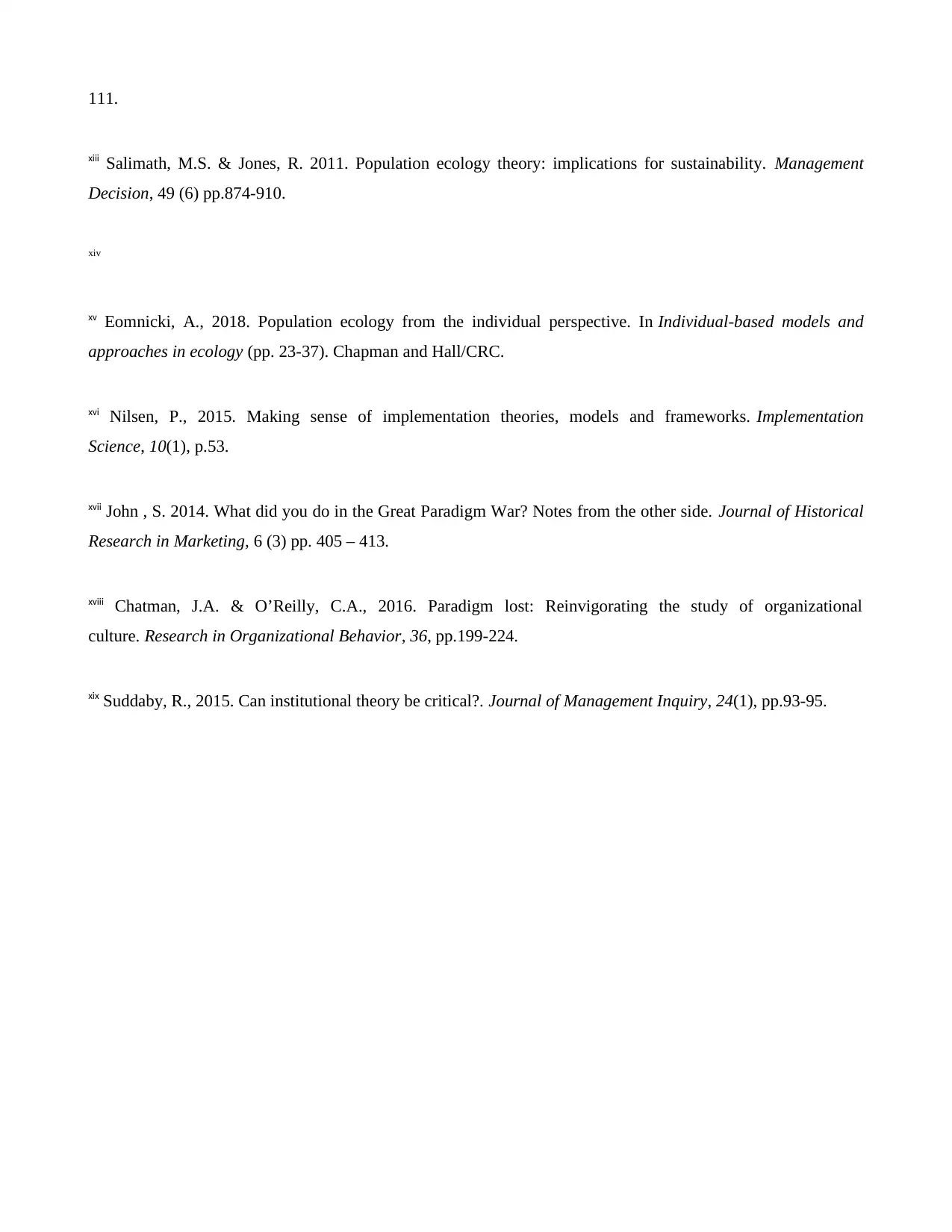
111.
xiii Salimath, M.S. & Jones, R. 2011. Population ecology theory: implications for sustainability. Management
Decision, 49 (6) pp.874-910.
xiv
xv Eomnicki, A., 2018. Population ecology from the individual perspective. In Individual-based models and
approaches in ecology (pp. 23-37). Chapman and Hall/CRC.
xvi Nilsen, P., 2015. Making sense of implementation theories, models and frameworks. Implementation
Science, 10(1), p.53.
xvii John , S. 2014. What did you do in the Great Paradigm War? Notes from the other side. Journal of Historical
Research in Marketing, 6 (3) pp. 405 – 413.
xviii Chatman, J.A. & O’Reilly, C.A., 2016. Paradigm lost: Reinvigorating the study of organizational
culture. Research in Organizational Behavior, 36, pp.199-224.
xix Suddaby, R., 2015. Can institutional theory be critical?. Journal of Management Inquiry, 24(1), pp.93-95.
xiii Salimath, M.S. & Jones, R. 2011. Population ecology theory: implications for sustainability. Management
Decision, 49 (6) pp.874-910.
xiv
xv Eomnicki, A., 2018. Population ecology from the individual perspective. In Individual-based models and
approaches in ecology (pp. 23-37). Chapman and Hall/CRC.
xvi Nilsen, P., 2015. Making sense of implementation theories, models and frameworks. Implementation
Science, 10(1), p.53.
xvii John , S. 2014. What did you do in the Great Paradigm War? Notes from the other side. Journal of Historical
Research in Marketing, 6 (3) pp. 405 – 413.
xviii Chatman, J.A. & O’Reilly, C.A., 2016. Paradigm lost: Reinvigorating the study of organizational
culture. Research in Organizational Behavior, 36, pp.199-224.
xix Suddaby, R., 2015. Can institutional theory be critical?. Journal of Management Inquiry, 24(1), pp.93-95.
1 out of 12
Related Documents
Your All-in-One AI-Powered Toolkit for Academic Success.
+13062052269
info@desklib.com
Available 24*7 on WhatsApp / Email
![[object Object]](/_next/static/media/star-bottom.7253800d.svg)
Unlock your academic potential
© 2024 | Zucol Services PVT LTD | All rights reserved.



